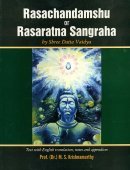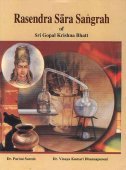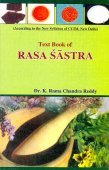Kamsya, Kāṃsya, Kāṃsyā: 27 definitions
Introduction:
Kamsya means something in Buddhism, Pali, Hinduism, Sanskrit, Marathi, Hindi. If you want to know the exact meaning, history, etymology or English translation of this term then check out the descriptions on this page. Add your comment or reference to a book if you want to contribute to this summary article.
Kamsya has 26 English definitions available.
Alternative spellings of this word include Kansy.
Languages of India and abroad
Sanskrit dictionary
[Deutsch Wörterbuch]
Source: Cologne Digital Sanskrit Dictionaries: Böhtlingk and Roth Grosses Petersburger WörterbuchKāṃsya (कांस्य):—(von kaṃsa) [Pāṇini’s acht Bücher 4, 3, 168] (von kaṃsīya, was wohl Messing bedeutet). [155] (eine neue Bild. von kāṃsya).
1) adj. messingen: vāraṇena sruveṇa kāṃsyena vā [Śāṅkhāyana’s Śrautasūtrāṇi 4, 16, 5. 15.] [Kātyāyana’s Śrautasūtrāṇi 2, 3, 5. 22, 10, 31.] śubhaṃ pātraṃ tu kāṃsyaṃ syāttenāgniṃ praṇayet [Gṛhyasaṃgrahapariśiṣṭa 1, 68.] na pādau dhāvayetkāṃsye kadācidapi bhājane [Manu’s Gesetzbuch 4, 65.] [Rāmāyaṇa 4, 50, 33.] kāṃsyabhājana (kann auch subst. Messing sein) [Suśruta 1, 74, 19. 2, 446, 15.] —
2) n. a) Messing [Hemacandra’s Abhidhānacintāmaṇi 1049.] [Anekārthasaṃgraha 2, 351.] [Medinīkoṣa y. 11.] [Manu’s Gesetzbuch 5, 114. 11, 167. 12, 62.] [Yājñavalkya’s Gesetzbuch 1, 190.] [Suśruta 1, 228, 2.] — b) ein messingenes Trinkgeschirr [Hemacandra’s Anekārthasaṃgraha] [Medinīkoṣa] [Śāṅkhāyana’s Śrautasūtrāṇi 4, 21, 8.] [ŚIKṢĀ 29.] [Pāraskara’s Gṛhyasūtrāṇi 1, 3. 3, 4.] [Suśruta 1, 171, 9. 2, 181, 10. 502, 12.] [Mahābhārata 2, 1751.] bālajena nidānena kāṃsyaṃ bhavatu dohanam [Mahābhārata 13, 4587.] kāṃsyadohā (gauḥ) [3517.] kāṃsyadohanā [2, 1910.] [Rāmāyaṇa 1, 72, 23.] kāṃsyopadohā [Mahābhārata 3, 12725. 12727.] Vgl. auch [Atharvavedasaṃhitā 18, 3, 17.] — c) ein best. musik. Instrument [Hemacandra’s Anekārthasaṃgraha] [Medinīkoṣa] — d) ein best. Maass (vgl. kaṃsa und die Beispiele unter b) [Hemacandra’s Anekārthasaṃgraha]
--- OR ---
Kāṃsya (कांस्य):—
2) a) yathā traputāmrayoḥ saṃyoge dhātvantarasya kāṃsyasyotpattiḥ [Scholiast] zu [Vājasaneyisaṃhitā 1, 126.] na suvarṇe dhvanistādṛgyādṛkkāṃsye prajāyate [Spr. 1624. 4657.] — b) [ŚIKṢĀ 29] gehört zu a), [Mahābhārata 13, 4587. 3517. 2, 1910.] [Rāmāyaṇa 1, 72, 23.] [Mahābhārata 3, 12725. 12727] zu 1). Trinkgeschirr überh.: loha [Hemacandra’s Anekārthasaṃgraha 3, 70.] [Medinīkoṣa k. 123]; vgl. mṛtkāṃsya .
Source: Cologne Digital Sanskrit Dictionaries: Sanskrit-Wörterbuch in kürzerer FassungKāṃsya (कांस्य):——
1) Adj. messingen [Mahābhārata 13,94,41.] —
2) n. — a) Messing. — b) ein messingenes Gefäss. Am Ende eines adj. Comp. f. ā [Hemādri’s Caturvargacintāmaṇi 1,463,21.] — c) *ein best. Hohlmaass. — d) *ein best. musikalisches Instrument.
Sanskrit, also spelled संस्कृतम् (saṃskṛtam), is an ancient language of India commonly seen as the grandmother of the Indo-European language family (even English!). Closely allied with Prakrit and Pali, Sanskrit is more exhaustive in both grammar and terms and has the most extensive collection of literature in the world, greatly surpassing its sister-languages Greek and Latin.
See also (Relevant definitions)
Starts with (+9): Kamsyabha, Kamsyabhadrishtimandala, Kamsyabhajana, Kamsyadi, Kamsyadirasa, Kamsyadoha, Kamsyadohana, Kamsyaghana, Kamsyaja, Kamsyaka, Kamsyakara, Kamsyakaraka, Kamsyakoshi, Kamsyala, Kamsyamakshika, Kamsyamala, Kamsyamaya, Kamsyana, Kamsyanila, Kamsyanili.
Ends with: Mritkamsya, Udakamsya.
Full-text (+49): Kamsa, Kamsyakara, Kamsyanila, Kamsyatala, Kamsyamala, Kamshi, Kamsyadoha, Mritkamsya, Kamsyamaya, Kamsyanili, Kamsyabhajana, Kamsyopadoha, Kamsyapatri, Kamsyapatra, Asurahva, Kamsaka, Dohana, Upadhatu, Kamsyakoshi, Kamsyaghana.
Relevant text
Search found 17 books and stories containing Kamsya, Kāṃsya, Kāṃsyā, Kāmsya; (plurals include: Kamsyas, Kāṃsyas, Kāṃsyās, Kāmsyas). You can also click to the full overview containing English textual excerpts. Below are direct links for the most relevant articles:
Garga Samhita (English) (by Danavir Goswami)
Verse 4.8.29 < [Chapter 8 - In the Story of the Yajña-sītās, the Glories of Ekādaśī]
Verses 4.8.26-27 < [Chapter 8 - In the Story of the Yajña-sītās, the Glories of Ekādaśī]
Verse 5.19.10 < [Chapter 19 - The Festival on Śrī Kṛṣṇa Return]
Rasa Jala Nidhi, vol 3: Metals, Gems and other substances (by Bhudeb Mookerjee)
Part 1 - Characteristics of Bell-metal (kamsya) < [Chapter IX - Mixed metals (2): Kamsya (bell-metal)]
Chapter IX - Mixed metals (2): Kamsya (bell-metal)
Part 1 - Characteristics of Varta-loha < [Chapter X - Mixed metals (3): Varta-loha]
Manusmriti with the Commentary of Medhatithi (by Ganganatha Jha)
Verse 4.231 < [Section XV - Charity]
Verse 5.110 < [Section XIII - Purification of Substances]
Verse 12.62 < [Section IX - Details of Transmigration]
Nitiprakasika (Critical Analysis) (by S. Anusha)
Pināka (Trident) < [Chapter 3]
Sushruta Samhita, Volume 6: Uttara-tantra (by Kaviraj Kunja Lal Bhishagratna)
Chapter IV - Pathology of the diseases of the sclerotic coat < [Canto I - Shalakya-tantra (ears, eyes, nose, mouth and throat)]
The Shiva Purana (by J. L. Shastri)
Chapter 26 - The deception or dodging of Kāla < [Section 5 - Umā-Saṃhitā]
Related products



